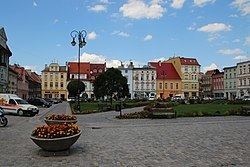Time zone CET (UTC+1) Area 6.83 km² | Town rights 1327 Postal code 48-340 Population 14,879 (2007) Local time Monday 2:48 AM | |
 | ||
Weather 1°C, Wind E at 6 km/h, 86% Humidity | ||
Głuchołazy [ɡwuxɔˈwazɨ] (German: Bad Ziegenhals) is a town in Nysa County, in Opole Voivodeship of southwestern Poland, near the border with the Czech Republic. It is the administrative seat of the Gmina Głuchołazy.
Contents
Map of G%C5%82ucho%C5%82azy, Poland
Głuchołazy has a canting arms - the shield features a goat's head in reference to its former German name, Ziegenhals, which literally means "goat's neck". The town was part of Prussia, then Germany, until 1945.
Geography
The town is located in the historic Upper Silesia region on the northern slopes of the Opawskie Mountains, in the valley of the Biała River. As of 2013, it has 14,297 inhabitants.
History
The settlement in the episcopal Duchy of Nysa was established about 1220 by German settlers who were called by the ruling Bishop Lawrence of Wrocław to build up a stronghold against the threatening forces of the Přemyslid margrave Vladislaus III of Moravia, brother of King Ottokar I of Bohemia. The place soon became an important site of iron ore and gold mining run by the Thurzó and Fugger families, it had received town privileges already in 1263. The town was devastated in 1428 during the Hussite Wars.
After the First Silesian War and the 1742 Treaty of Breslau the Duchy of Nysa was partitioned and Głuchołazy became a Prussian bordertown, while the adjacent area around Zlaté Hory remained with Austrian Silesia. In the 19th century it became a spa town (Bad). After World War II the remaining German population was expelled and with the implementation of the Oder-Neisse line in 1945, the area was transferred to the Republic of Poland.
Twin towns — Sister cities
Głuchołazy is twinned with:
